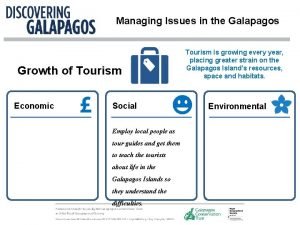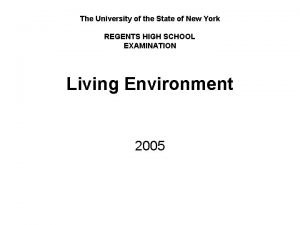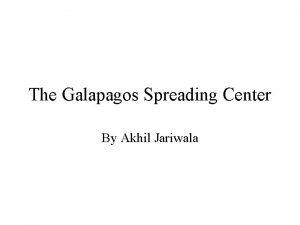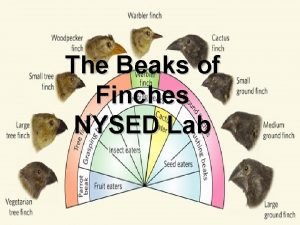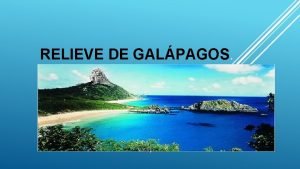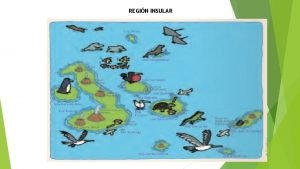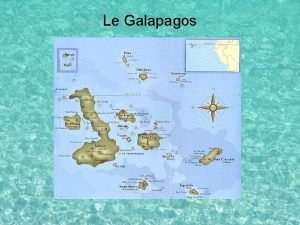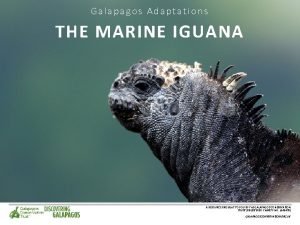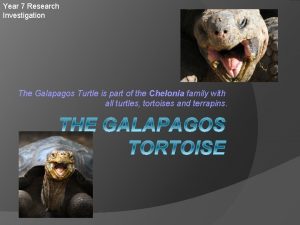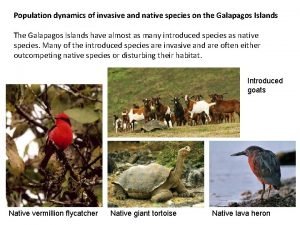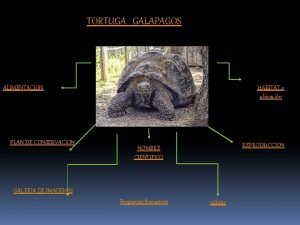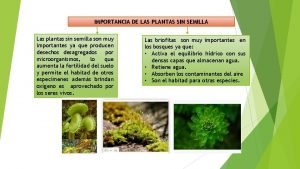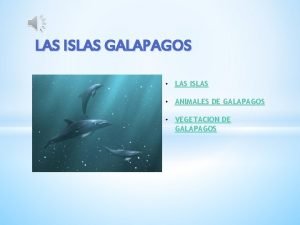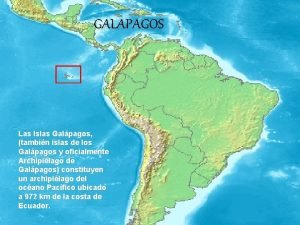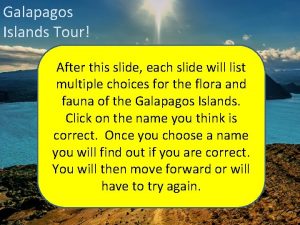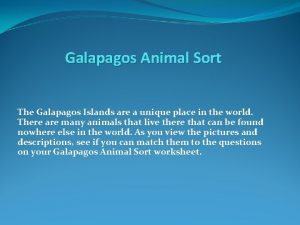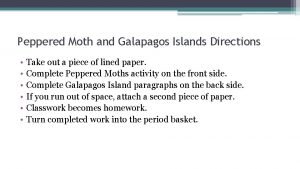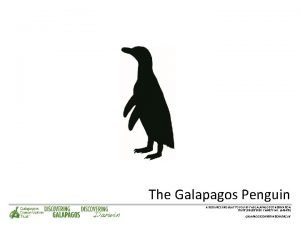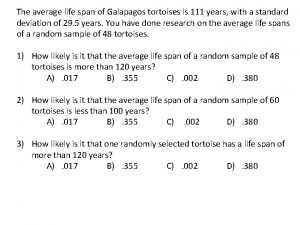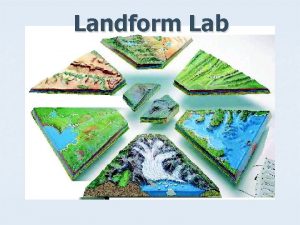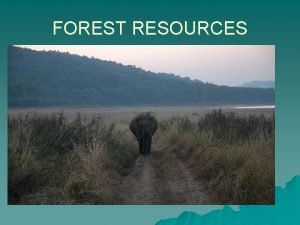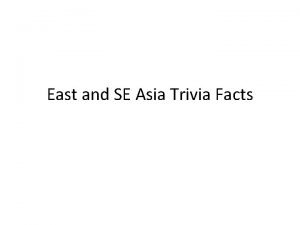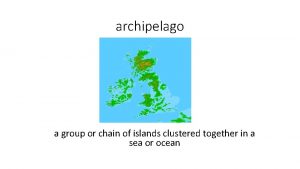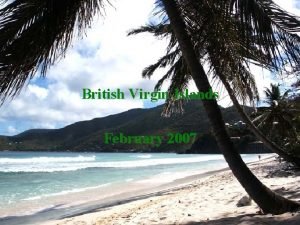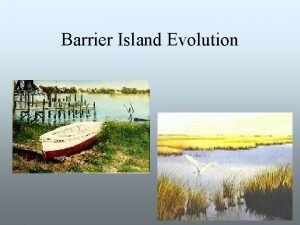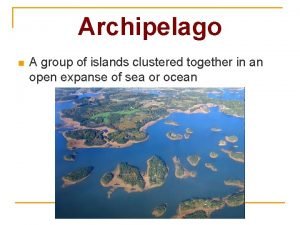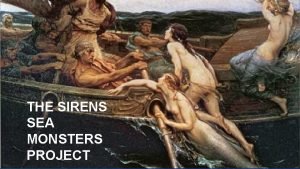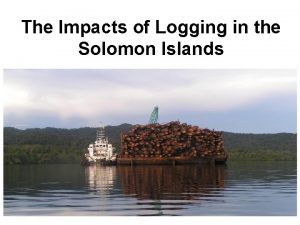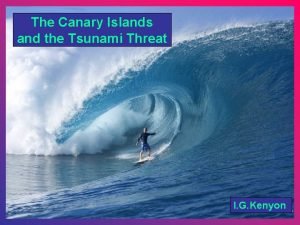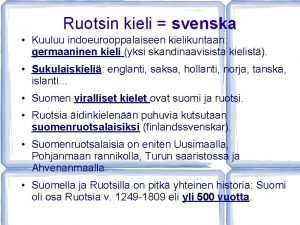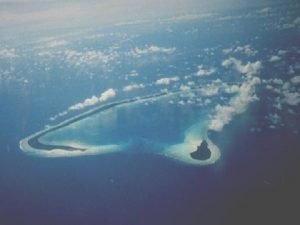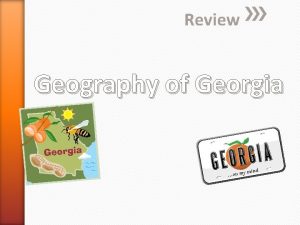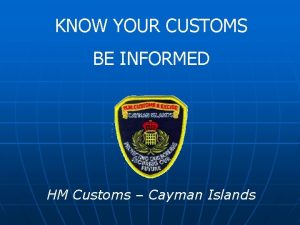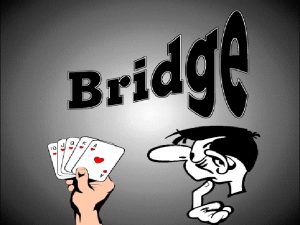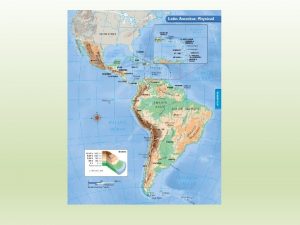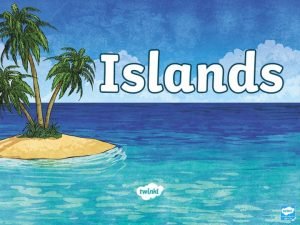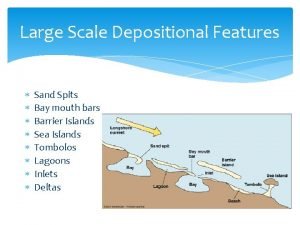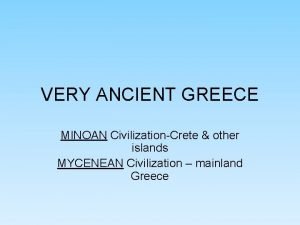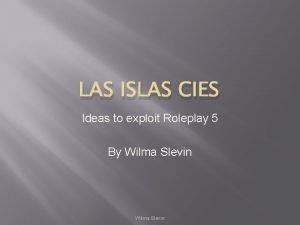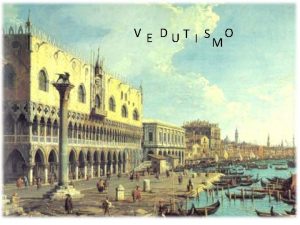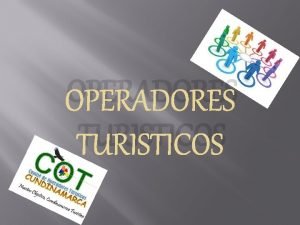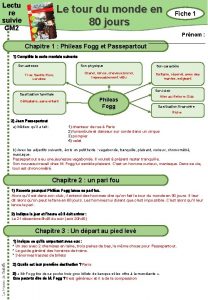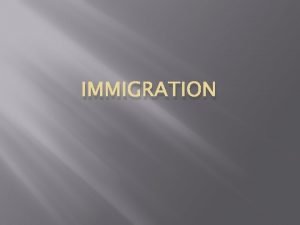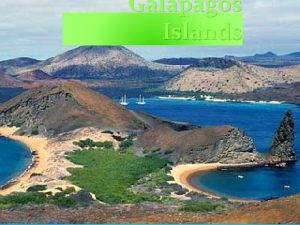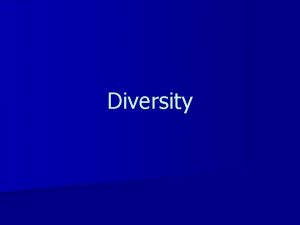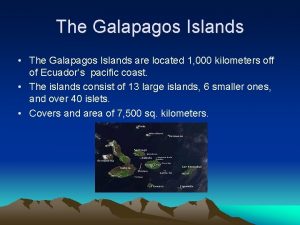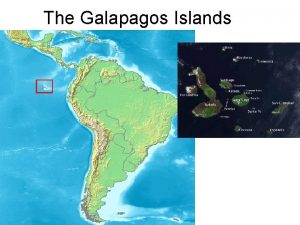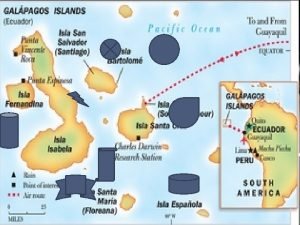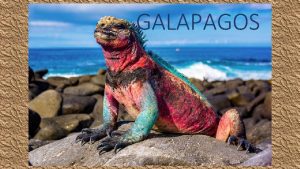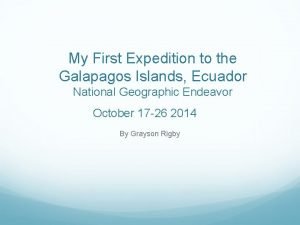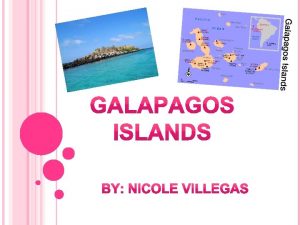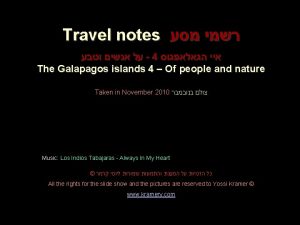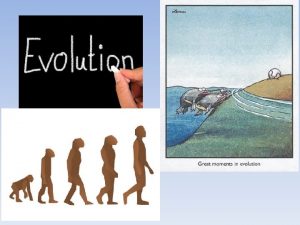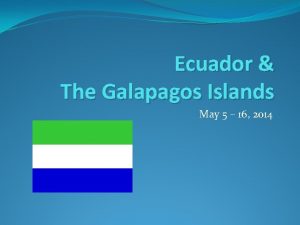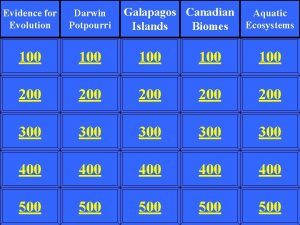Galapagos Islands Tour After this slide each slide






























































































- Slides: 94

Galapagos Islands Tour! After this slide, each slide will list multiple choices for the flora and fauna of the Galapagos Islands. Click on the name you think is correct. Once you choose a name you will find out if you are correct. You will then move forward or will have to try again.

Fire Crab Devil Crab Sally Lightfoot Crab



Galapagos Walrus Galapagos Sea Lion California Sea Lion



Charles Darwin



Domed Saddle Back Intermediate



Domed Saddle Back Intermediate



Domed Saddle Back Intermediate



Waved Albatross Blue Footed Booby Galapagos Hawk



Waved Albatross Blue Footed Booby Galapagos Hawk



Waved Albatross Galapagos Short Eared Owl Galapagos Hawk



Galapagos Land Iguana Galapagos Marine Iguana Galapagos Lava Lizard



Galapagos Land Iguana Galapagos Marine Iguana Galapagos Lava Lizard



Galapagos Land Iguana Galapagos Marine Iguana Galapagos Lava Lizard



Galapagos Redneck Hawk Galapagos Vulture Galapagos Frigate Bird



Galapagos Flightless Cormorant Galapagos Vulture Galapagos Brown Duck



Galapagos Ground Finch Galapagos Tree Finch Galapagos Cactus Finch



Galapagos Ground Finch Galapagos Tree Finch Galapagos Cactus Finch



Galapagos Ground Finch Galapagos Vegetarian Tree Finch Galapagos Cactus Finch



Galapagos Rock Owl Galapagos Short Eared Owl Galapagos Night Hawk



Galapagos Cormorants Galapagos Penguins Galapagos Sea Gulls



Galapagos Tree Finch Galapagos Cactus Finch Galapagos Woodpecker Finch



Native Goats Galapagos Sheep and Rams Invasive Goats



Galapagos Carpenter Bee (male) Galapagos Carpenter Bee (female) Galapagos Wasp (male)



Galapagos Carpenter Bee (male) Galapagos Carpenter Bee (female) Galapagos Wasp (male)



Native Cat with Marine Iguana Invasive (Feral) Cat with Marine Iguana Native Cat with Lava Lizard



Native Dog with Marine Iguana Invasive (Feral) Dog with Marine Iguana Native Dog with Lava Lizard



This fish is actually a pretty bad swimmer, and uses its pectoral fins to walk on the bottom of the ocean. Red Lipped Bat Fish Walking Cat Fish



SS Explorer HSM Beagle USS Discovery On the morning of December 27 th 1831, a crew of seventy-three men, sailed out of Plymouth harbor under a calm easterly wind and drizzly rain. Charles Darwin became seasick almost immediately and started to have second thoughts about the voyage.



Species Review – How many do you remember? Click on the picture for the answer!

These birds have a wave-like pattern of the feathers when they become adults Waved Albatross

I Can’t Fly but I sure can swim! Click on the picture for the answer! Galapagos Flightless Cormorant

Girls have a white neck, I have a red one! Click on the picture for the answer! Galapagos Frigate Bird (male)

I can live up to and over 100 years! Click on the picture for the answer! Galapagos Giant Tortoise

I am the most abundant reptile on the Galapagos Islands. There are 7 different species of me on the Galapagos Islands. I play an important part in controlling over-populated insect populations such as the Painted Locust. I am usually 6 inches long but can grow to 12 inches. Click on the picture for the answer! Galapagos Lava Lizard

I am also known as a “Red Rock Crab”. I am one of the most common crabs along the western coast of South America and can be seen along the entire coast of Central America, Mexico and nearby islands. Click for the answer! Sally Lightfoot Crab

A stretch of sea or ocean containing a group of islands such as the Galapagos, Patagonia, Bermuda, The British Isles, The Cayman Islands and The Florida Keys is known as an - Archipelago

The Voyage of HMS Beagle – December 27, 1831 - October 2, 1836.

Perhaps our first association with the word "Galapagos" is the name "Darwin. " Darwin's visit to the Galapagos Islands had a resounding impact on the formation of his Theory of Natural Selection. A rather unmotivated and failing medical scholar, Charles Darwin accompanied Captain Robert Fitzroy as a travel companion and naturalist on the HMS Beagle. His book The Voyage of the Beagle is an account of his worldwide journey. When setting off from England in 1831 for a five-year voyage, Darwin had little ambitions for groundbreaking scientific research. After surveying the coasts of South America, the ship stopped over in the Galapagos Islands.

During his visit to the islands, Darwin noted that the unique creatures were similar from island to island, but perfectly adapted to their environments which led him to ponder the origin of the islands' inhabitants. Among those that struck Darwin so greatly were the finches that are now named in his honor. Darwin would later base some of his thought from the supposing that these finches were all descendents of the same lineage. Years later in 1859, Darwin finally consolidated all of his observations into his famous book On The Origin of Species, drastically and controversially altering the scientific view on the biological origins of life.

 Galapagos islands
Galapagos islands Tour eiffel tours petronas shanghai world financial
Tour eiffel tours petronas shanghai world financial Tour guide vs tour escort
Tour guide vs tour escort Bad world tour
Bad world tour After me after me after me
After me after me after me John 14:1
John 14:1 Heel and toe step
Heel and toe step Galapagos finches evolved partly due to
Galapagos finches evolved partly due to Galapagos spreading center
Galapagos spreading center Beaks of finches lab
Beaks of finches lab Relieve insular
Relieve insular Dibujo de la región insular
Dibujo de la región insular Cosa mangiano le iguane
Cosa mangiano le iguane Galapagos iguana adaptations
Galapagos iguana adaptations Galapagos finches evolved partly due to
Galapagos finches evolved partly due to Tortoise classification
Tortoise classification Galapagos
Galapagos Galapagos
Galapagos Bioclima pluvial
Bioclima pluvial History of computer animation
History of computer animation Tortuga galapagos habitat
Tortuga galapagos habitat Importancia de las plantas
Importancia de las plantas Archipielago de galapagos
Archipielago de galapagos Site:slidetodoc.com
Site:slidetodoc.com Islas galpagos
Islas galpagos Galapagos carpenter bee
Galapagos carpenter bee Galápagos tortoise
Galápagos tortoise Galapagos pepper
Galapagos pepper Galapagos penguin habitat map
Galapagos penguin habitat map Galapagos turtle lifespan
Galapagos turtle lifespan Rewrite each expression with rational exponents.
Rewrite each expression with rational exponents. Identify each line or segment that intersects each circle
Identify each line or segment that intersects each circle Is a oxbow lake constructive or destructive
Is a oxbow lake constructive or destructive Northern island in japan
Northern island in japan Faroe island vs israel
Faroe island vs israel Why did the athenians sail to nearby islands in panic?
Why did the athenians sail to nearby islands in panic? Deforestation
Deforestation English speaking islands in caribbean
English speaking islands in caribbean Xi jiang river
Xi jiang river Bionicle nui kopen
Bionicle nui kopen A group or chain of islands clustered together
A group or chain of islands clustered together Channel islands nursing program cost
Channel islands nursing program cost Islands in kuwait
Islands in kuwait Seattle to virgin islands
Seattle to virgin islands Barrier beaches diagram
Barrier beaches diagram A group or chain of islands clustered together
A group or chain of islands clustered together Trobriand islands
Trobriand islands Maglalatik classification
Maglalatik classification Summit rhode islands toursism
Summit rhode islands toursism Sirens greek mythology facts
Sirens greek mythology facts Advantages and disadvantages of logging
Advantages and disadvantages of logging La palma tsunami threat
La palma tsunami threat Kuuluisia suomenruotsalaisia
Kuuluisia suomenruotsalaisia Study islands
Study islands Piccap
Piccap San blas islands molas
San blas islands molas Islands of excellence in a sea of mediocrity
Islands of excellence in a sea of mediocrity Which statement identifies a reason to preserve wetlands?
Which statement identifies a reason to preserve wetlands? Cayman islands customs online
Cayman islands customs online Bridgesamband íslands
Bridgesamband íslands Islands off of florida
Islands off of florida Islands off of florida
Islands off of florida What defines an island
What defines an island Pitcairn islands
Pitcairn islands Mouth bay
Mouth bay Callinectes sapidus
Callinectes sapidus Gaps and islands
Gaps and islands Automation integrators
Automation integrators What did the minoan civilization trade with other islands
What did the minoan civilization trade with other islands Cies islands permit
Cies islands permit Insert clustered column chart
Insert clustered column chart Cook islands chamber of commerce
Cook islands chamber of commerce Csu channel islands application deadline
Csu channel islands application deadline Scottish islands federation
Scottish islands federation Canary islands gdp
Canary islands gdp Molecules slide past each other
Molecules slide past each other Factor binomials
Factor binomials Tourist welcome
Tourist welcome Tour of body.com
Tour of body.com Virtual bus tour
Virtual bus tour Vedutismo mappa concettuale
Vedutismo mappa concettuale Virtual tour sarthe
Virtual tour sarthe Tour the collectives of cyberspace
Tour the collectives of cyberspace Tbilisi trip packages
Tbilisi trip packages Euler tour traversal
Euler tour traversal Gif tour eiffel
Gif tour eiffel Tipos de operadores turísticos
Tipos de operadores turísticos Enquiry letter to travel agency
Enquiry letter to travel agency Carte mentale le tour du monde en 80 jours
Carte mentale le tour du monde en 80 jours Teurgole
Teurgole Http://teacher.scholastic.com/activities/immigration/tour/
Http://teacher.scholastic.com/activities/immigration/tour/ Google tour builder
Google tour builder What-does-tourist-guide-do
What-does-tourist-guide-do Virtual cell tour
Virtual cell tour Virtual supermarket tour
Virtual supermarket tour
